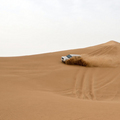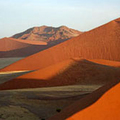Eco-friendly locations / The Largest Deserts in the World / The Rub Al Khali Desert
The Rub Al Khali Desert
A significant part of the Arabian Peninsula is probably the most arid desert in the world. It was called the Rub al-Khali. Rub al-Khali is a vast sandy desert in the Middle East which occupies the southern third of the Arabian Peninsula , one of the largest deserts in the world . It is one of the hottest (average maximum in July and in August is 47 ° C, the mark at 50 ° C and regularly overcome) and the dry deserts of the world ( the annual precipitation is ≈ 35 mm, evaporation> 2000 mm), and thus , the desert is classified as an arid desert. The desert has an area of 650 000 km ² . It is located between 44 ° 30 'and 56 ° 30'. on, 16 ° 30 'and 23 ° 00' on the territory of Saudi Arabia , Oman , UAE and Yemen .
Description
In Arabic, the name of the desert means "nothing." If you look at it from the airplane, it would seem that someone fell a vast territory with sand and leveled everything. It's really a flat desert. Although, there are some hills and height of 200-300m in the form of dunes and sand hills.It occupies the south-eastern area of the Arabian Peninsula, an area of 600 km2. The Rub al-Khali is divided between the four Arab countries: Saudi Arabia, UAE, Oman and Yemen. Rub al-Khali is a sedimentary basin, extending from the southwest to the northeast across the Arabian shelf . The sand is on the top of gravel or gypsum , the height of the dunes is up to 250 m. The sand is predominantly of silicate , 80 to 90% of quartz , the rest feldspar , grains of which is coated with iron oxide , sand paint in orange and red. The sandy desert in the southeast of the Arabian Peninsula is situated in a tectonic depression between the mountains, stretching along the western, the southern and the eastern shores of the Arabian Peninsula. The surface has a plain height of 100-200m in the East and 500-1000m in the west. About 80% of the territory is occupied by mobile sand, forming dunes (up to 150-200 m), ridges and individual arrays. Extensive salt marshes, rocky places among the sand plains are in the East. The precipitation is less than 50 mm per year, often do not fall for several years. Standing there is no runoff, the water table is deep. Vegetation is mainly in depressions between sand ridges (camel-thorn, soups, etc.). The population consists mainly of Arabs. The population of the desert has been breeding camels. The main wealth of the eastern deserts of the Rub al-Khali is, of course, the oil and the gas fields. On the outskirts of the Rub al Khali are rare oases. The largest oases are Liwa and Al Ain. But the most picturesque, perhaps, is Al Jiwa, which stretches for 50 km. This is one of the harshest places on the earth.
Others The Largest Deserts in the World .
Maps of The Rub Al Khali Desert
mapOthers from The Largest Deserts in the World
Under such dry conditions it is hard for the plants to live and the soils to form.
There is anything that protects the earth from overheating in these areas.
The hottest place on the Earth is the tropical desert, but there are coldest , even icy deserts, for instance, Antarctica.
Deserts cover approximately 20% of the Earth's land surface and 80% in Australia , therefore, a fifth of the Earth's land area belongs to the deserts.
Many of the major deserts are located near the tropics, such as the Sahara desert which is the largest desert in the world, as well as the Kalahari, the Namib Desert and the Grand Victoria in Australia.
Droughts During the grazing of cattle during droughts disorders of vegetation occur.
They are so significant that are likely unrecovered.
The sun's rays quickly dry the soil and turn to dust, which happens to desertification, a continuous transformation of the land in the desert.
A desert with a change in climatic conditions can always shrink and expand.
The long-term global climate change or contraction of the continents can garden the desert or turn it into a magnificent forest.
Short-lived changes in weather conditions influence the expansion of its borders, turning occasionally green areas in arid deserts.
The hottest places on the Earth are the tropical desert, where the daytime temperatures often reach +50 ° C.
This heat can destroy the stones and give the landscape an unusual character.
The underground water evaporates so quickly that minerals are dissolved from the crust.
Deserts are constantly dry, but in other natural areas prolonged dry periods can occur - the droughts.
Their presence in any place depends on what kind of rainfall is there.
There was a drought in Sahel, Africa, that lasted many months without rain.
However, droughts are regular and in some places they are with a typical moisture content, such as the North American grasslands which dry up every 22 years.
Water plays a significant role in shaping the dry landscape, despite of its low quantity in the desert .
Water alters the chemical composition of rocks, now and then it is dumped in the desert from the sky, at times becoming the cause of short, but strong flash floods, which are harmful to the soil.
Do all the deserts have very high temperatures and a lot of sand? We call a desert an area where not more than 25 inches of rain falls per year.
As a rule, deserts are formed in the hot desert climates, but there are exceptions.
Most deserts have a lot of rocks and stones and sand.
What is the biggest desert? The most extensive deserts are located in areas of high atmospheric pressures.
All the winds blow in areas of their inner regions, but the moist winds from the sea reach them very rarely.
There are those deserts, which are near the sea, and yet the sea winds will reach them, they lose most of moisture on the way.
Certain deserts are formed on the internal continental slopes of mountain ranges, well sheltered from the sea winds.
Almost all of Antarctica is a huge frozen desert, which is located in an area of high pressure, so that its interior is extremely small drops of fresh snow.
The driest desert in the world.
In many deserts there is no rain for several years in a row, then a short downpour happens and everything starts all over again.
The most arid desert is the Atacama Desert in South America .
Until 1971, there were 400 years without spilling a drop.
It is known that in several places in the desert, there are artesian waters, but the high boron content makes them unsuitable for irrigation.
What is an oasis? An oasis is a plot of land in the desert, which is covered with vegetation.
It feeds from underground springs or natural wells.
The largest desert in the world The largest desert in the world is the Sahara Desert in North Africa.
Its area is of approximately 8400 sq.
km.
However, only ten percent of its territory is covered with sand, and everything else is taken by bare rocks and stones.
After Sahara, we have the Arabian desert, the Gobi, the Patagonian,the Rub’ al Khali, the Great Victoria, the Kalahari, the Great Basin, the Chihuahuan and the Thar.



















